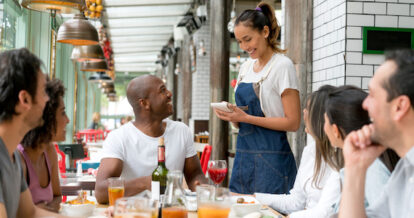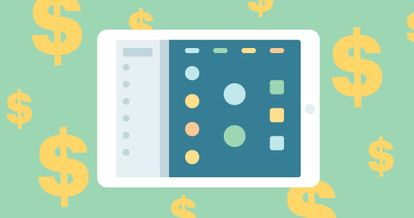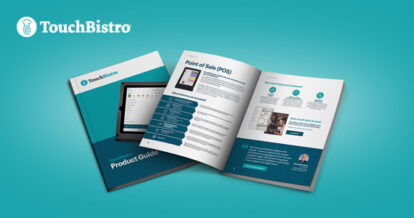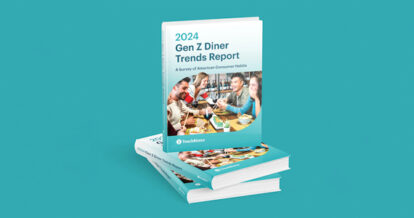Table turnover rate is one of the most important metrics for restaurateurs to track because it has a direct impact on your bottom line. In short, the more people you can seat per day, the more sales you generate.
Fortunately, table turnover rate is also one of the easiest metrics to measure and control.
While it’s a bit of a balancing act, you can maximize your table turnover rate with just a few simple tweaks. Something as simple as changing the decor or using a mobile POS system can help you achieve a table turn rate that’s long enough for guests to enjoy their meal, but short enough that new guests don’t have to wait long to be seated.
Hitting this table turnover sweet spot not only ensures your guests enjoy better service, but it also means that you’ll be able to seat more diners during service – something that translates into more revenue overall.
To help you put these table turnover strategies into action, this article will cover:
- The definition of table turnover rate
- How to calculate table turnover rate for your restaurant
- 13 ways to maximize your restaurant table turnover rate
What Is Table Turnover Rate?
In a restaurant, table turnover rate measures how often parties occupy your tables during a specific period of time.
Table turnover rate is important to measure because every restaurant has a fixed capacity. This means that the number of diners that can be served at any given time is limited to the number of tables you have.
However, a high seat table turnover rate helps you work within the limitations of your capacity. The more guests you can seat and serve in a given time period, the more sales you can make. Therefore, your restaurant’s profitability is directly tied to your table turnover rate.
How to Calculate Table Turnover Rate for Your Restaurant
To calculate your restaurant table turnover rate, you’ll need to take the following steps:
1. Select the period of time you want to measure. This could be a specific meal time, or it can be a specific day.
2. Count the number of parties (or covers) served at each table during this specific measurement period. This information should be readily available from your POS reports.
3. Divide the number of parties served by the number of tables to get your total table turnover rate.
For example, let’s say you wanted to calculate your table turnover rate during last Friday’s dinner rush. You have 15 tables in your restaurant, and your POS reports show that you served 45 parties during that dinner service. To find your restaurant’s table turnover rate, your calculation would look like this:
45 parties served ÷ 15 tables = 3
This calculation reveals that your table turnover rate for dinner is 3. This means during dinner service, you can expect to flip each table three times.
Average Restaurant Table Turnover Rate
To better understand how your table turnover rate compares to other restaurants, it’s helpful to know the averages across the industry.
For a family restaurant, the average table turnover rate is 3. During the dinner period of 5 p.m. to 10 p.m., this translates into each table flipping after an hour and a half.
However, keep in mind that your table turnover rate is dependent on a number of variables, and a good rate for one type of restaurant may be different than another.
For instance, your restaurant may be filled with large tables with many seats – something that is often the case for fine dining venues. If you have more people at these big tables, serving these parties will take longer and you won’t be able to turn over the tables as quickly. In this case, it may be more valuable to focus on increasing average check size per customer, rather than increasing the table turnover rate.
Average Seat Turnover Rate
To help you better understand how many people you can expect to serve on average, you can also measure seat turnover rate, which is the average amount of times each seat in your restaurant will be occupied in a given time period.
To find your average seat turnover rate, divide the number of customers served in a given time period by the number of available seats.
Using the same example as above, you may have 15 tables, but 60 seats total. If you sat 120 guests total during dinner service your average seat turnover rate calculation would be as follows:
120 guests ÷ 60 seats = 2
In this case, your average seat turnover rate is lower than your average table turnover rate. This means that even though you’re turning tables over fairly quickly, you’re not filling all the seats you have available. For example, you might have a lot of four-person tables, but most of the parties that come in are couples.
By calculating your seat turnover rate in addition to your table turnover rate, you can get a better sense of whether you’re truly maximizing your restaurant’s available capacity.
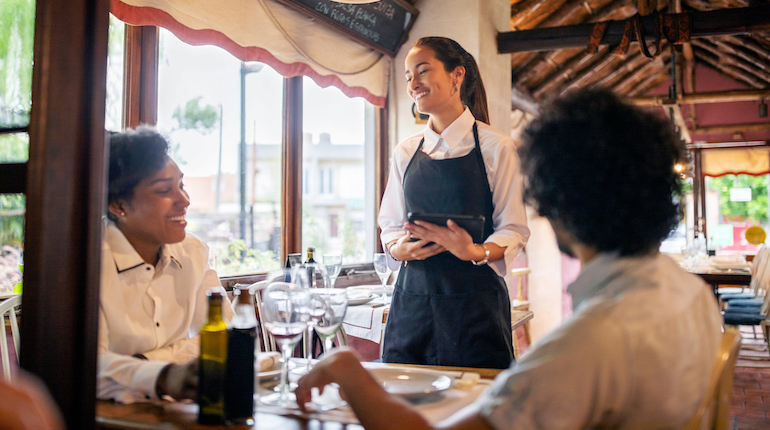
13 Ways to Maximize Your Restaurant’s Table Turnover Rate
If your own table turnover rate is less than stellar, there are plenty of strategies and tricks you can try to bring that number up.
Below, we’ve listed 13 tips for maximizing table turnover rate. To help you identify the right strategies for your restaurant, we’ve grouped these tips into three separate categories: server training, technology, and restaurant design.
Server Training
Your servers play an essential role in improving your restaurant’s table turnover rate. With just a few small tweaks to server training, you can ensure your front-of-house (FOH) team is moving like a well-oiled machine.
1. Encourage servers to work as a team
One of the best ways to improve your table turnover rate is to do away with a rigid emphasis on individual server sections. Instead, encourage your servers to work together as a team and to help with each other’s tables when needed. For instance, if a customer wants to modify their order, any server passing by should be encouraged to help – especially if you’re using a restaurant POS system that lets your servers access all orders.
Encouraging your servers to work as a team means customers never have to wait for their dedicated server to place an order, modify a dish, or ask for the bill. Ultimately, this means shorter wait times for customers and faster table turnover.
2. Take orders by seat
Encouraging your FOH staff to work as a team is also easier when you train your servers to take orders by seat. For instance, if you use a POS system like TouchBistro, servers can enter orders for each individual seat, rather than the table as a whole.
Taking orders by seat helps to speed up service because servers know exactly where each dish is going – there’s no time spent second guessing or asking who ordered what. This streamlined system also makes it possible for servers who aren’t assigned to a specific table to help bring orders to specific guests.
3. Consolidate visits to the table
No matter what kind of technology your servers are working with, they should be making a conscious effort to consolidate their trips to each table. For instance, servers shouldn’t be making one trip to introduce themselves and then another trip to bring water, when both tasks could be accomplished in one single trip.
By encouraging FOH staff to consolidate the number of visits to each table, you ensure they’re more efficient with their time and customers spend less downtime waiting on servers. This tip is especially important on extra busy days like Mother’s Day or the 4th of July.
4. Don’t seat incomplete parties
Another tactic you can use to increase table turnover rates is to not seat incomplete parties.
As your servers have probably observed, when diners wait for the rest of their party to arrive, it causes a major bottleneck in service and table turnover times go way down – the exact opposite of what you want.
The best way to avoid these kinds of costly delays is to ask your servers to enforce a “no seating incomplete parties” policy during busy shifts. During slower shifts, you can relax this policy as these kinds of parties don’t present the same risk to service.
Technology
Of course, improving your table turn rates shouldn’t be left entirely to your servers. Some other ways you can speed up service is by upgrading the technology you use in your restaurant.
5. Use mobile POS systems
One of the biggest culprits of a low table turnover rate is using a legacy POS system. That’s because legacy POS systems are generally made up of wired hardware that has to live in one fixed spot in your restaurant. And when the POS system is fixed in one place, it means servers have to make constant trips to and from the POS system to punch in orders, modify orders, or generate bills.
Switching POS providers from a legacy system to a modern, cloud POS is one of the easiest ways to solve this problem. Modern POS systems are made up of wireless POS terminals – like iPad tablets – that can be moved freely throughout the restaurant. This allows servers to take tablets tableside and input orders immediately. This means orders are sent to the kitchen faster and customers receive their food faster. In turn, this means less downtime for diners and much faster table turnover rates.
Just take the case of the Crosstown Pub & Grill in Naperville and Batavia, Illinois. The restaurant originally used a legacy POS system that made the order process slow and inefficient – up to 25 minutes with cooking time. However, when Crosstown made the switch to TouchBistro’s mobile POS system with tableside ordering, the pub was able to get customers in and out in 15 minutes – perfect for a busy lunchtime crowd. In fact, during the restaurant’s highest periods, Crosstown Pub turns over 176 more tables than they previously did with a traditional POS system.
6. Promote online reservations
Another piece of technology that can help promote better table turn times is a restaurant reservation system. If you use a digital reservations management system like TouchBistro Reservations, you can send guests a reservation confirmation email with your menu. This allows guests to review your menu ahead of time so they already know what they want when they arrive – something that translates to much faster order times.
Not to mention, promoting reservations helps you get a better sense of how many parties you can expect on a given night. For instance, if you know you have a lot of parties booked, you can ensure you have enough FOH and back-of-house (BOH) staff on hand to move service along quickly and maximize table turn times.
7. Add a digital waitlist feature
Like reservations, a digital waitlist feature is a great way to speed up service. For instance, if you use TouchBistro Reservations, you can enable a tool called Google Waitlist. This allows walk-in guests to add themselves to a digital waitlist if there are no tables available within a 15- or 30-minute window.
While they’re waiting, guests can scan your online menu and determine what they want to order in advance. Once guests sit down, this makes for a speedy ordering process.
8. Implement contactless dining
Another surefire way to speed up the ordering process? Let your guests do the ordering themselves.
In recent years, many restaurants have implemented contactless dining solutions. These platforms allow customers to view your menu, place their order, and pay, all from their personal devices. By empowering customers to place their own orders, it means staff spend less time tableside waiting for diners to order or pay. This can dramatically speed up service and ultimately improve table turnover times.
9. Use contactless payments
Technology is not just a great way to speed up the ordering process, but it can also help you save time during the checkout process.
If your restaurant still uses a legacy POS system and fixed payment terminals, servers need to make several trips to print out checks, get signatures from customers, and process the transactions. But if you use mobile payment terminals, your servers can quickly take payments right at the table, significantly cutting down on the number of trips to each table.
You can speed up the checkout process even further by opting for credit card readers equipped to accept contactless payments. This means that customers simply need to hover their credit card, debit card, or their smartphone’s mobile wallet over the credit card reader to pay – no need to insert a card into the reader or fumble with the PIN pad. In fact, with Visa’s contactless credit cards, transactions take as little as half a second to process, which translates into faster table turnover rates.
10. Deep dive into POS reports
Lastly, don’t underestimate the value of your POS reports. Even though you now know how to calculate table turnover rate, this number is only part of the picture.
Specific POS reports such as your staff performance report can show you valuable metrics such as average dining duration by server and average spend. When these two figures are used in conjunction, you can find out who is turning tables over quickly and who is not. This information can ultimately help you identify opportunities to improve training and make sure all your servers are working as efficiently as possible.

Restaurant Design
Lastly, a few simple design tweaks can have a big impact on your restaurant table turnover rate.
11. Limit your menu size
One of the easiest ways to increase table turnover is to simply limit the size of your menu. Large menus often lead to decision fatigue, which is when customers are faced with so many choices that they have trouble choosing anything at all. In turn, this means customers will take longer to order.
In contrast, a small menu makes the decision process significantly easier and faster for customers, which can help to limit the total time a party spends at the table. And if a customer is still stuck on what to order, you can instruct your servers to recommend dishes that are faster to prepare.
12. Prep certain menu items ahead of time
All those little tasks that staff carry out during service may not seem like a barrier to faster table turnover, but that time adds up quickly. For instance, something like filling ramekins with popular sauces and dressing can eat into a server’s time when done repeatedly throughout service.
Where possible, save time by preparing certain menu items in advance. This can be as simple as filling water pitchers in advance or even partially preparing popular menu items like desserts. Just be careful that none of this prepwork impacts the overall quality of your food.
13. Adjust the decor and atmosphere
Though you might think your decor has little impact on your table turnover rate, you’d be surprised the difference a few small adjustments can make. Consider tweaking the following to speed up service:
- Music: Try playing restaurant music with a more upbeat tempo. Studies have shown that people are much more likely to eat faster when fast tempo music is playing in the background than when slow tempo music is playing.
- Temperature: Studies have found that the ideal dining room temperature is somewhere between 69-72 degrees fahrenheit. However, lowering the temperature a little bit can encourage customers to eat faster. One study by German researchers found that lowering the temperature of a dining room by 10 degrees boosted food consumption nearly 20%.
- Color Scheme: Warm colors such as yellows, reds, and oranges are more stimulating and can keep guests engaged. Just think about how many high-volume, fast food restaurants rely on this exact color scheme to keep guests coming and going.
- Seating: Make your seating comfy, but not too comfy. Plush booths or chairs may cause guests to linger, so be careful to choose seating that diner’s won’t want to fall asleep in.
- Tables: If you notice your core clientele is couples, adjust your tables accordingly. Do away with booths and large tables so you can seat a greater number of parties at once.
No matter what type of restaurant you run, paying attention to your table turnover rate can make a big impact on your overall revenue. And now that you know how to calculate table turnover rate and the different table turn strategies you can employ, you have the tools you need to get started.
Download our free inventory template
Sign up for our free weekly TouchBistro Newsletter

